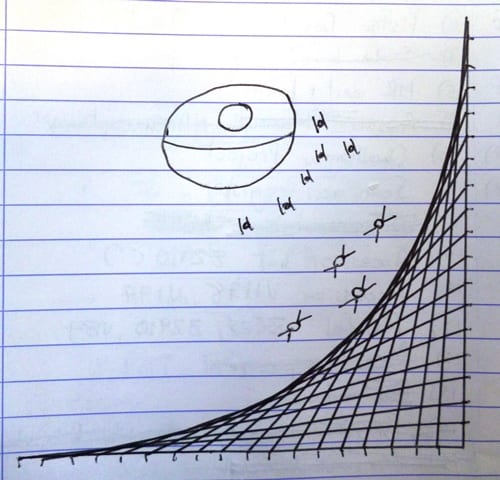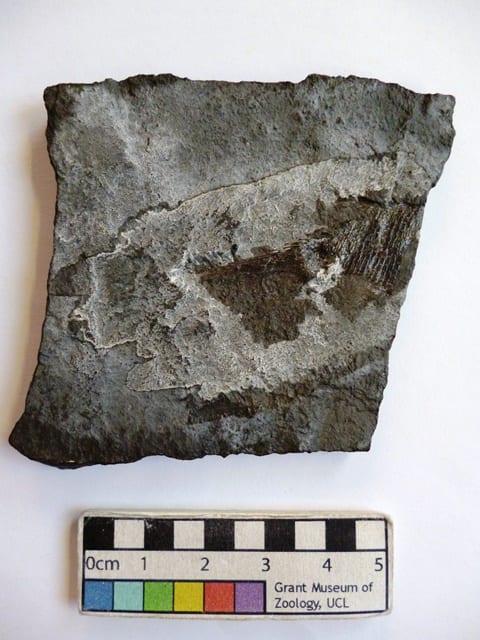Underwhelming Fossil Fish of the Month: May 2015
By Mark Carnall, on 29 May 2015
It’s only taken a total of 30 months of monthly underwhelming fossil fish, but the series has finally received the overdue recognition that it deserves. The series, which stops to take a look at the less sexy, less interesting and generally underwhelming fish fossils that every natural history museum has in its stores, has been recognised as a tour de force in the museum/palaeo/biology blogosphere. There are so many people to thank but I deserve most of the credit to be honest. I am of course talking about the first ever Underwhelming Fossil Fish of the Month fan art*. That’s when you know you’ve really made it. Here it be:

(c) Up-and-coming-palaeo-cartoonist and Curator of Natural History, Plymouth City Museum & Art Gallery, Jan Freedman
This cartoon, showing a bald lady talking to Brian May about fossil fish was first unveiled at last week’s Natural Sciences Collections Association conference, Museums Unleashed, about the power of social media and sums up this blog series in one image. But that’s enough boasting about how underwhelming fossil fish transcend media, we all knew this to be true so without further ado let’s clamp our peepers on this month’s rough in the diamonds.
Look at this beauty. It shimmers, it shines, it doesn’t really look like anything and it’s a bit broken. “Perfect specimen to celebrate the 31st underwhelming fossil fish of the month” I thought to myself. What is it you ask? Well hopefully this helpful reconstruction from yet another up-and-coming-young-mid-thirties-but-actually-looks-like-he-could-be-in-his-mid-to-late-twenties-palaeo artist (also available for palaeobiologically-themed funerals, weddings, Bar and Bat Mitzvah commissions) will help.

This reconstruction really helps to bring to life this underwhelming fossil. Talent like this can’t be taught, you have to be born with it.
Of course! You say. This is a tip of a tail of European Carboniferous ray-finned fish, Canobius ramsayi named by Scottish palaeontologist Ramsay Traquair in 1881 and most likely from Glencartholm, Eskdale! And you would be spot on, reader. Spot on. There’s not much more to say here I guess.
Preservation As far as bits of Canobius that it might be interesting to find, the tip of the tail is way down in the rankings. However, as far as tips of tails go, it’s a rather nice one. What we appear to have here is the upper lobe of the tail and the lepidotrichia, that’s fin rays to you and me, that make up the rest of the fin. From the white border around this specimen and the break and a fold through the very end of the tail it looks like this fish was partly disturbed during preservation, We can see the rather beautiful arrangement of scales that look a bit like those graphs you drew in the back of school books that end up looking like a planet surface which must have a proper name but which escapes me right now. These things.

Those graphy things that presumably have a better name. This one embellished with X-wings about to engage a squadron of TIE fighters with the Death Star looming in the background. Also somewhat resembles the scales on the tail of Canobius
Research From a quick literature search, there’s not been a huge amount of research on Canobius ramsayi or Canobius in general. Like so many underwhelming fossil fish before it, it’s a genus and species that is often referred to in passing. One ‘interesting’ factlet if you like that kind of thing is it may seem like Ramsay Traquair, who first described this species, was being particularly conceited by naming Canobius ramsayi after himself, a practice very much frowned upon. However, this species is actually named after Professor Andrew Ramsay who was a Professor of geology at UCL and later the director-general of the Geological Survey.
In society Canobius hasn’t had much of an impact on wider society. However it does sound a little bit like cannabis. It’s also very close to Canopius, the global specialty (re)insurance lines platform of Sompo Japan Nipponkoa Holdings Inc. Is it just coincidence that both are highly uninspiring? I think not…
Canobius ramsayi
Preservation 5
Research 3
Society 0.333
Underwhelmingness 7.5
* Safe for work fan art**
** That wasn’t created by me.
Mark Carnall is the Curator of the Grant Museum of Zoology
UPDATE: 29/05/2015. Correct job title given to Jan Freedman and new accession number added.
3 Responses to “Underwhelming Fossil Fish of the Month: May 2015”
- 1
-
2
Helen Chavez wrote on 1 June 2015:
Ah! At last! Recognition! And is it a coincidence that the palaeo-artist has returned to their cunning-yet-sexy reconstructions just ONE MONTH after I mentioned that they were so sorely missed! If only politicians were as attentive! And also fan art. Gobsmackingly awesome, to use the vernacular of today’s youth. Not only that, but to include a STAR WARS association … TIE fighters. Death Star. Simply breathtaking.
And to manage all of this with the tip of a fishy tail. Kudos, sir. Kudos.
-
3
Underwhelming Fossil Fish of the Month: May 2016 | UCL Museums & Collections Blog wrote on 31 May 2016:

[…] boys and girls. Underwhelming fossil fish come in all shapes and sizes, some are virtually nothing, others inspire great works of art but once in a while we get one that is surprisingly and distinctly fish shaped. It’s still […]
 Close
Close



I’m glad to see that you’ve tempted back the palaeo artist. It really brings the specimen to life. Or, in this case, death.